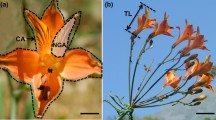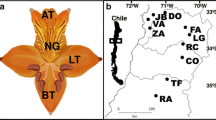Abstract
Floral visitor assemblages within plant populations are usually composed of different visitors, and the relative abundance of these visitors also varies. Therefore, identifying the relative strength of these floral visitors driving floral evolution within the population is an important step in predicting the evolutionary trajectory of floral traits. Using supplemental hand pollination and nectar-robbing exclusion treatments, we experimentally identified the relative strengths of legitimate pollinators (that visit flowers through the corolla tube entrance) and nectar robbers (that visit flowers by biting a hole in the corolla tube or using an existing hole) driving floral evolution within the Primula secundiflora population. We also estimated legitimate pollinator- and nectar robber-mediated selection separately for pin and thrum flowers. Both legitimate pollinators and nectar robbers mediated selection on pollination efficiency traits in P. secundiflora population. Legitimate pollinators mediated selection for wider corolla tubes, whereas nectar robbers mediated selection for longer corolla tubes. In addition, nectar robber-mediated selection on corolla tube length marginally varied between the pin and thrum flowers. Nectar robber mediated selection for longer corolla tube length in the pin flowers not in the thrum flowers. These results indicate that legitimate pollinators and nectar robbers within a population can drive differential evolutionary trajectories of floral traits.



Similar content being viewed by others
References
Ågren J, Fortunel C, Ehrlén J (2006) Selection on floral display in insect-pollinated Primula farinosa: effects of vegetation height and litter accumulation. Oecologia 150:225–232
Ågren J, Hellström F, Toräng P, Ehrlén J (2013) Mutualists and antagonists drive among-population variation in selection and evolution of floral display in a perennial herb. Proc Natl Acad Sci USA 110:18202–18207
Arnold SJ, Wade MJ (1984) On the measurement of natural and sexual selection: applications. Evolution 38:720–734
Bartkowska MP, Johnson MO (2012) Pollinators cause stronger selection than herbivores on floral traits in Lobelia cardinalis (Lobeliaceae). New Phytol 193:1039–1048
Boberg E, Ågren J (2009) Despite their apparent integration, spur length but not perianth size affects reproductive success in the moth-pollinated orchid Platanthera bifolia. Funct Ecol 23:1022–1028
Brody AK (1997) Effects of pollinators, herbivores, and seed predators on flowering phenology. Ecology 78:1624–1631
Brunet J (2009) Pollinators of the Rocky Mountain columbine: temporal variation, functional groups and associations with floral traits. Ann Bot 103:1567–1578
Cariveau D, Irwin RE, Brody AK, Garcia-Mayeya LS, von der Ohe A (2004) Direct and indirect effects of pollinators and seed predators to selection on plant and floral traits. Oikos 104:15–26
Chapurlat E, Ågren J, Sletvold N (2015) Spatial variation in pollinator-mediated selection on phenology, floral display and spur length in the orchid Gymnadenia conopsea. New Phytol 208:1264–1275
Charlesworth D, Charlesworth B (1979) A model for the evolution of distyly. Am Nat 114:467–498
Darwin C (1859) On the origin of species. Murray, London
Darwin C (1877) The different forms of flowers on plants of the same species. Murray, London
deVos JM, Wüest RO, Conti E (2014) Small and ugly? Phylogenetic analyses of the “selfing syndrome” reveal complex evolutionary fates of monomorphic primrose flowers. Evolution 68:1042–1057
Ehrlén J, Käck S, Ågren J (2002) Pollen limitation, seed predation and scape length in Primula farinosa. Oikos 97:45–51
Elzinga JA, Atlan A, Biere A, Gigord L, Weis AE, Bernasconi G (2007) Time after time: flowering phenology and biotic interactions. Trends Ecol Evol 22:432–439
Fenster CB (1991) Selection on floral morphology by hummingbirds. Biotropica 23:98–101
Fenster CB, Armbruster WS, Wilson P, Dudash MR, Thomson JD (2004) Pollination syndromes and floral specialization. Annu Rev Ecol Evol Syst 35:375–403
Ferrero V, Castro S, Sánchez JM, Navarro L (2011) Stigma-anther reciprocity, pollinators, and pollen transfer efficiency in populations of heterostylous species of Lithodora and Glandora (Boraginaceae). Plant Syst Evol 291:267–276
Geerts S (2016) Can short-billed nectar thieving sunbirds replace long-billed sunbird pollinators in transformed landscapes? Plant Biol 18:1048–1052
Gómez JM, Perfectti F, Bosch J, Camacho JPM (2009) A geographic selection mosaic in a generalized plant-pollinator-herbivore system. Ecol Monogr 79:245–263
Grindeland JM, Sletvold N, Ims RA (2005) Effects of floral display size and plant density on pollinator visitation rate in a natural population of Digitalis purpurea. Funct Ecol 19:383–390
Harder LD, Johnson SD (2009) Darwin’s beautiful contrivances: evolutionary and functional evidence for floral adaptation. New Phytol 183:530–545
Hodgins KA, Barrett SCH (2008) Natural selection on floral traits through male and female function in wild populations of the heterostylous daffodil Narcissus triandrus. Evolution 62:1751–1763
Huang SQ, Wang XP, Sun SG (2016) Are long corolla tubes in Pedicularis driven by pollinator selection? J Integr Plant Biol 58:698–700
Inouye DW (1980) The terminology of floral larceny. Ecology 61:1251–1253
Irwin RE, Brody AK (2011) Additive effects of herbivory, nectar robbing and seed predation on male and female fitness estimates of the host plant Ipomopsis aggregata. Oecologia 166:681–692
Irwin RE, Galen C, Rabenold JJ, Kaczorowski R, McCutcheon ML (2008) Mechanisms of tolerance to floral larceny in two wildflowers species. Ecology 89:3093–3104
Kálmán K, Medvegy A, Pénzes Z, Mihalik E (2007) Morph-specific variation of floral traits associated with reciprocal herkogamy in natural populations of Primula vulgaris and Primula veris. Plant Syst Evol 268:15–27
Kessler A, Halitschke R (2009) Testing the potential for conflicting selection on floral chemical traits by pollinators and herbivores: predictions and case study. Funct Ecol 23:901–912
Lande R, Arnold SJ (1983) The measurement of selection on correlated characters. Evolution 37:1210–1226
Lara C, Ornelas JF (2001) Preferential nectar robbing of flowers with long corollas: experimental studies of two hummingbird species visiting three plant species. Oecologia 128:263–273
Lavi R, Sapir Y (2015) Are pollinators the agents of selection for the extreme large size and dark color in Oncocyclus irises? New Phytol 205:369–377
Lloyd D (1979) Evolution towards dioecy in heterostylous populations. Plant Syst Evol 131:71–80
Lloyd D, Webb CJ (1992) The selection of heterostyly. In: Barrett SCH (ed) Evolution and function of heterostyly. Springer, New York, pp 179–207
MacColl ADC (2011) The ecological causes of evolution. Trends Ecol Evol 26:514–522
Maruyama PK, Vizentin-Bugoni J, Dalsgaard B, Sazima I, Sazima M (2015) Nectar robbery by a hermit hummingbird: association to floral phenotype and its influence on flowers and network structure. Oecologia 178:783–793
Mast AR, Conti E (2006) The primrose path to heterostyly. New Phytol 171:439–442
Medel R, Valiente A, Botto-Mahan C, Carvallo G, Pérez F, Nélida P, Luis N (2007) The influence of insects and hummingbirds on the geographical variation of the flower phenotype in Mimulus luteus. Ecography 30:812–818
Navarro L, Medel R (2009) Relationship between floral tube length and nectar robbing in Duranta erecta L. (Verbenaceae). Biol J Linn Soc 96:392–398
Nishihiro J, Washitani I, Thomson JD, Thomson BA (2002) Patterns and consequences of stigma height variation in a natural population of a distylous plant, Primula sieboldii. Funct Ecol 14:502–512
Parachnowitsch AL, Kessler A (2010) Pollinators exert natural selection on flower size and floral display in Penstemon digitalis. New Phytol 188:393–402
Quinn GP, Keough MJ (eds) (2002) Experimental design and data analysis for biologists. Cambridge University Press, New York
Richards J (ed) (2014) Primula. Timber Press, Portland
Sandring S, Ågren J (2009) Pollinator-mediated selection on floral display and flowering time in the perennial herb Arabidopsis lyrata. Evolution 63:1292–1300
Schlindwein C, Westerkamp C, Carvalho AT, Milet-Pinheriro P (2014) Visual signalling of nectar-offering flowers and specific morphological traits favour robust bee pollinators in the mass-flowering tree Handroanthus impetiginosus (Bignoniaceae). Bot J Linn Soc 176:396–407
Sletvold N, Ågren J (2010) Pollinator-mediated selection on floral display and spur length in the orchid Gymnadenia conopsea. Int J Plant Sci 171:999–1009
Sletvold N, Moritz KK, Ågren J (2015) Additive effects of pollinators and herbivores result in both conflicting and reinforcing selection on floral traits. Ecology 96:214–221
Strauss SY, Irwin RE (2004) Ecological and evolutionary consequences of multispecies plant–animal interactions. Annu Rev Ecol Evol Syst 35:435–466
Temeles EJ, Pan IL (2002) Effect of nectar robbery on phase duration, nectar volume, and pollination in a protandrous plant. Int J Plant Sci 163:803–808
Toräng P, Ehrlén J, Ågren J (2006) Facilitation in an insect-pollinated herb with a floral display dimorphism. Ecology 87:2113–2117
Toräng P, Ågren J, Ehrlén J (2008) Mutualists and antagonists mediate frequency-dependent selection on floral display. Ecology 89:1564–1572
Van der Niet T, Peakall R, Johnson SD (2014) Pollinator-driven ecological speciation in plants: new evidence and future perspectives. Ann Bot 113:199–211
van Kleunen M, Ritland K (2004) Predicting evolution of floral traits associated with mating system in a natural plant population. J Evol Biol 17:1389–1399
Vanhoenacker D, Toräng P, Ågren J, Ehrlén J (2010) Morph-specific selection on floral traits in a polymorphic plant. J Evol Biol 23:1251–1260
Vanhoenacker D, Ågren J, Ehrlén J (2013) Non-linear relationship between intensity of plant-animal interactions and selection strength. Ecol Lett 16:198–205
Wang Q, Li YX, Pu X, Zhu LY, Tang Z, Liu Q (2013) Pollinators and nectar robbers cause directional selection for large spur circle in Impatiens oxyanthera (Balsaminaceae). Plant Syst Evol 299:1263–1274
Wu Y, Li QJ (2017) Phenotypic selection on flowering phenology and pollination efficiency traits between Primula populations with different pollinator assemblages. Ecol Evol 7:7599–7608
Yuan S, Barrett SCH, Duan TT, Qian X, Shi MM, Zhang DX (2017) Ecological correlates and genetic consequences of evolutionary transitions from distyly to homostyly. Ann Bot 120:775–789
Zhao ZG, Huang SQ (2013) Differentiation of floral traits associated with pollinator preference in a generalist-pollinated herb, Trollius ranunculoides (Ranunculaceae). Int J Plant Sci 174:637–646
Zhu XF, Wan JP, Li QJ (2010) Nectar robbers pollinate flowers with sexual organs hidden within corollas in distylous Primula secundiflora (Primulaceae). Biol Lett 6:785–787
Zhu XF, Jiang XF, Li L, Zhang ZQ, Li QJ (2015) Asymmetrical disassortative pollination in a distylous primrose: the complementary roles of bumblebee nectar robbers and syrphid flies. Sci Rep 5:7721–7727
Acknowledgements
We would especially like to thank Potatso National Park for the logistical support. We would sincerely like to thank the Center Laboratory of Xishuangbanna Tropical Botanical Garden, Chinese Academy of Sciences for help in the data collection. This research was supported by the Joint Funds of the National Natural Science Foundation of China and Yunnan Provincial Government (No. U1202261).
Author information
Authors and Affiliations
Corresponding author
Ethics declarations
Conflict of interest
The authors declare that they have no conflict of interest.
Electronic supplementary material
Below is the link to the electronic supplementary material.
Rights and permissions
About this article
Cite this article
Wu, Y., Zhong, T., Liu, GL. et al. The relative strength of different floral visitors driving floral evolution within a Primula secundiflora population. Evol Ecol 32, 587–599 (2018). https://doi.org/10.1007/s10682-018-9962-3
Received:
Accepted:
Published:
Issue Date:
DOI: https://doi.org/10.1007/s10682-018-9962-3




